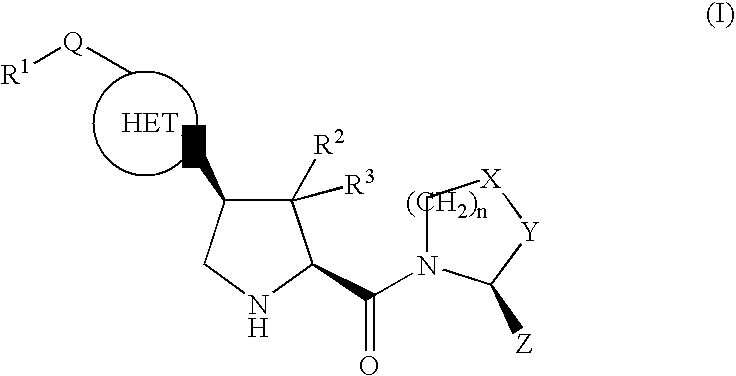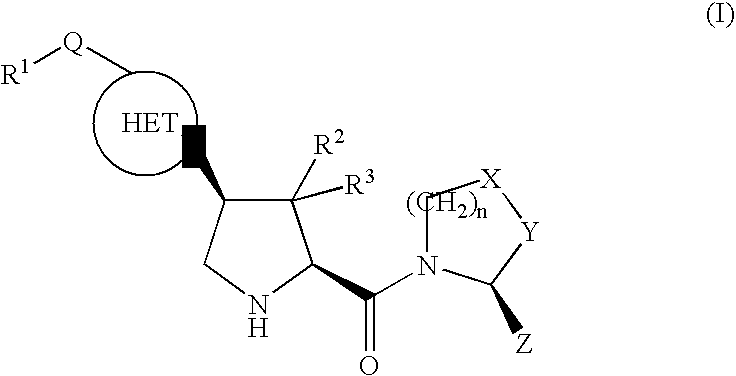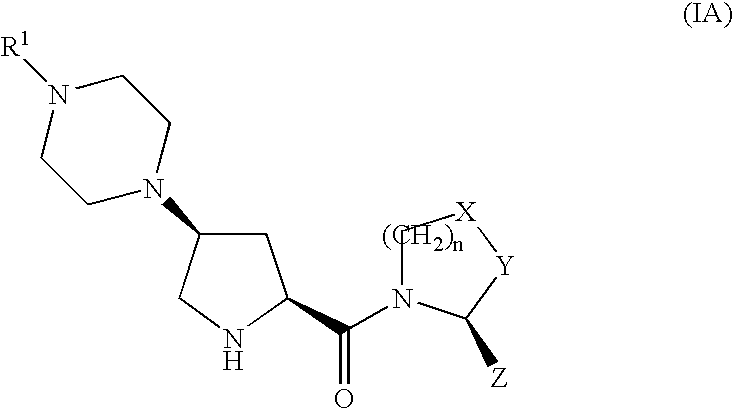Therapeutic compounds
a technology of dipeptidyl peptidaseiv and inhibitory activity, which is applied in the field of selective inhibitors of dipeptidyl peptidaseiv, can solve the problems of limiting use, clinically available hypoglycemic drugs can have side effects, and the treatment of diabetes remains less than satisfactory, and achieves the effect of equal or better dpp-iv inhibitory activity and higher plasma concentration
- Summary
- Abstract
- Description
- Claims
- Application Information
AI Technical Summary
Benefits of technology
Problems solved by technology
Method used
Image
Examples
preparation 1
tert-butyl-(2S)-2-[(3,3-Difluoropyrrolidin-1-yl)carbonyl]-4-oxopyrrolidine-1-carboxylate
Step 1—tert-butyl-(2S,4R)-2-[(3,3-Difluoropyrrolidin-1-yl)carbonyl]-4-hydroxypyrrolidine-1-carboxylate
[0129] TEA (0.77 mL, 5.5 mmol) was added to a suspension of 3,3-difluoropyrrolidine hydrochloride (0.79 g, 5.5 mmol; Synlett, 55 (1995)), in 10 mL of dichloromethane. After five min, (4R)-1-(tert-butoxycarbonyl)-4-hydroxy-L-proline (1.16 g, 5 mmol), HOBt (0.74 g, 5.5 mmol), and EDC (1.05 g, 5.5 mmol) were added. After stirring the reaction overnight, the mixture was washed sequentially with saturated sodium bicarbonate and brine, dried over magnesium sulfate, filtered, and concentrated. The residue was purified by chromatography (Biotage® Flash 40S (A Dynax Corp.; Charlottesville, Va.), 9:1 dichloromethane:methanol) to afford 1.07 g of a light pink foam. Additional product (0.26 g) was obtained by repeated dichloromethane extractions of the aqueous layer to provide an overall yield of 1.33 g (8...
preparation 2
tert-Butyl (2)-2-{[(3R*,4S)-3,4-difluoropyrrolidin-1-yl]carbonyl}-4-oxopyrrolidine-1-carboxylate
Step 1—tert-Butyl (2S,4R)-2-{[(3R*,4S)-3,4difluoropyrrolidin-1-yl]carbonyl}-4-hydroxypyrrolidine-1-carboxylate
[0133] (4R)-1-(tert-butoxycarbonyl)-4-hydroxy-L-proline (2.31 g, 10 mmol), was coupled with (3R,4S)-rel-3,4-difluoropyrrolidine hydrochloride (1.44 g, 10 mmol, Preparation 4), in a manner analogous to that described in Preparation 1, Step 1, to afford 2.15 g (67%) of the title product as an off-white foam. MS m / z 321 (MH+).
Step 2
[0134] The product of Step 1 (1.97 g, 6.15 mmol) was oxidized in a manner analogous to that described in Preparation 1, Step 2, to afford 0.74 g (38%) of the title compound as a light yellow solid. MS m / z 319 (MH+).
preparation 3
(4S)-1-(tert-Butoxycarbonyl)-4-(4-pyrimidin-2-ylpiperazin-1-yl)-L-proline
[0135] 1-(tert-Butoxycarbonyl)-4-oxo-L-proline (1.0 g, 4.4 mmol), 2-piperazin-1-ylpyrimidine (0.73 g, 4.4 mmol), and acetic acid (275 μL, 4.6 mmol) were dissolved in 20 mL of anhydrous 1,2-dichloroethane and sodium triacetoxyborohydride (1.85 g, 8.7 mmol) was added. After agitating at RT for 24 hr, the reaction mixture was quenched with saturated NaHCO3. The pH was adjusted to pH 7 by addition of solid NaHCO3 and concentrated HCl, the mixture was extracted with dichloromethane, dried over MgSO4, filtered, and concentrated to afford 1.0 (61%) of crude material that was sufficiently pure for further use. MS m / z 378 (MH+).
PUM
| Property | Measurement | Unit |
|---|---|---|
| Electrical conductance | aaaaa | aaaaa |
| Time | aaaaa | aaaaa |
| Time | aaaaa | aaaaa |
Abstract
Description
Claims
Application Information
 Login to View More
Login to View More - R&D
- Intellectual Property
- Life Sciences
- Materials
- Tech Scout
- Unparalleled Data Quality
- Higher Quality Content
- 60% Fewer Hallucinations
Browse by: Latest US Patents, China's latest patents, Technical Efficacy Thesaurus, Application Domain, Technology Topic, Popular Technical Reports.
© 2025 PatSnap. All rights reserved.Legal|Privacy policy|Modern Slavery Act Transparency Statement|Sitemap|About US| Contact US: help@patsnap.com



